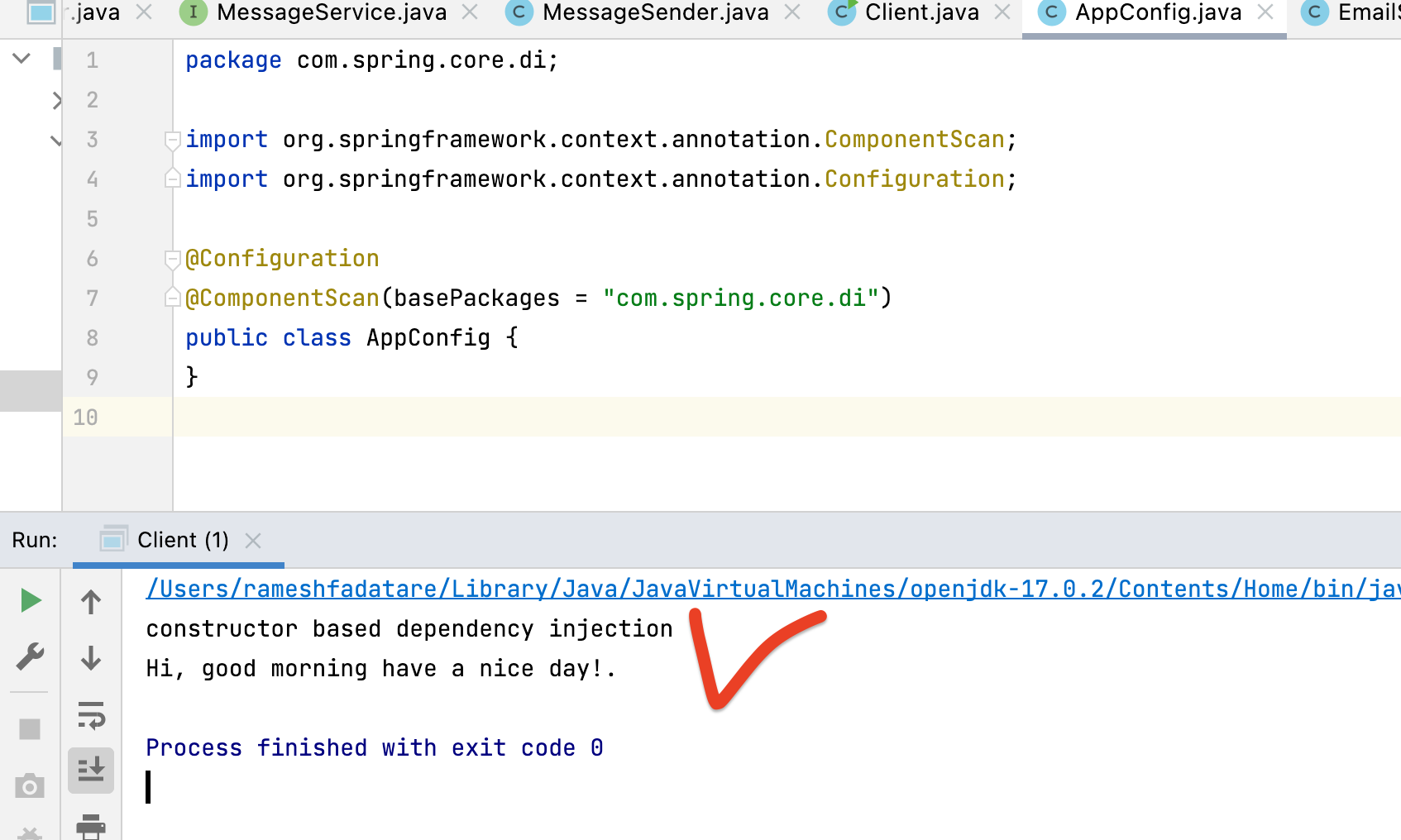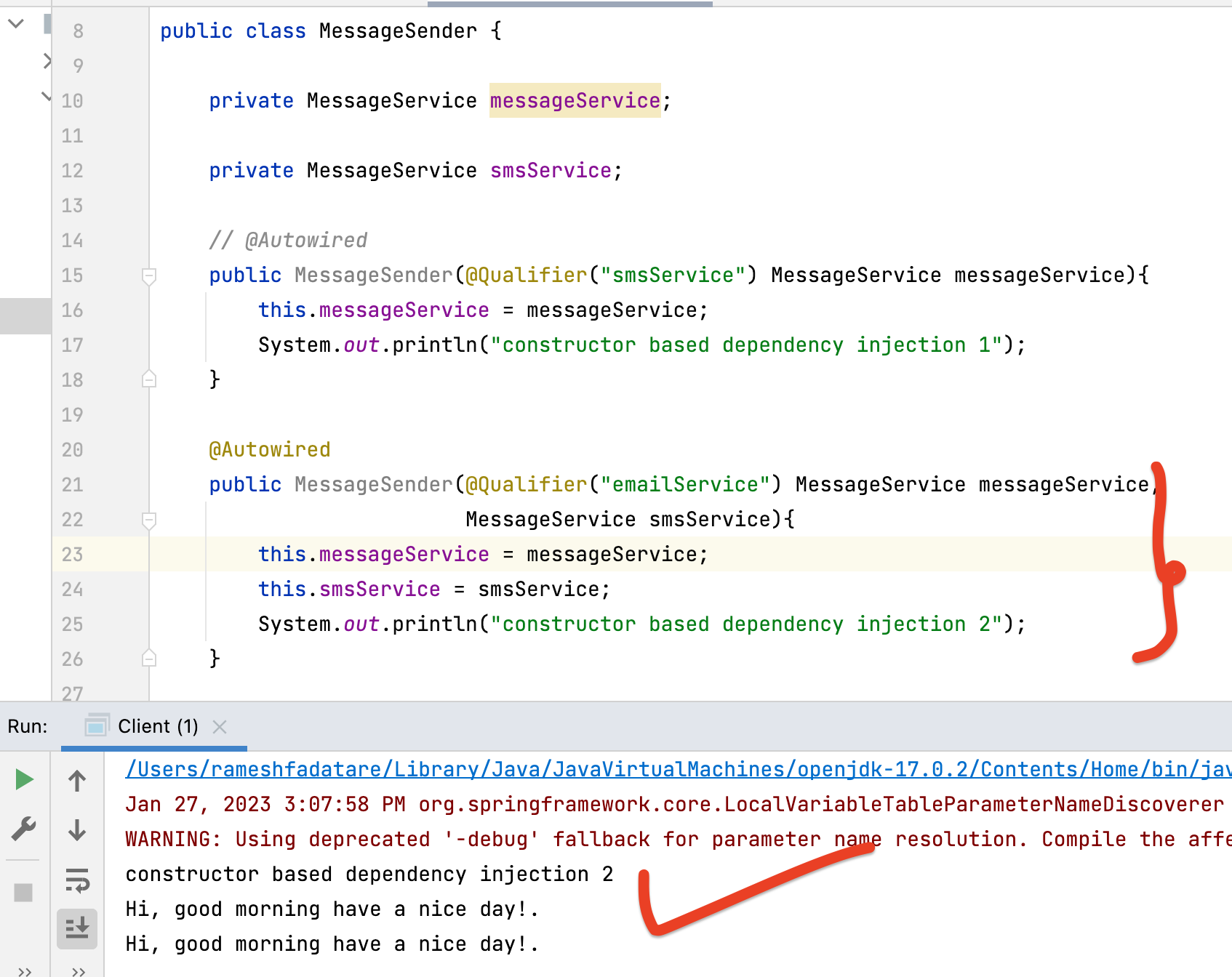📘 Premium Read: Access my best content on
Medium member-only articles
— deep dives into Java, Spring Boot, Microservices, backend architecture, interview preparation, career advice, and industry-standard best practices.
✅ Some premium posts are free to read — no account needed.
Follow me on Medium to stay updated and support my writing.
🎓 Top 10 Udemy Courses (Huge Discount):
Explore My Udemy Courses
— Learn through real-time, project-based development.
▶️ Subscribe to My YouTube Channel (172K+ subscribers):
Java Guides on YouTube
In this tutorial, we will learn how to use constructor-based dependency injection in the Spring boot application.
Dependency Injection is a design pattern on which dependency of the object is injected by the framework rather than created by the Object itself - It is also called IOC (Inversion of Control).
Dependency Injection reduces coupling between multiple objects as its dynamically injected by the framework. Spring IoC Container uses DI to inject one object into another object.
There are mainly three types of Dependency Injection:
- Constructor Injection
- Setter Injection
- Field Injection
In this tutorial, we will see step by step how to use constructor-based dependency injection in the Spring boot application.
Constructor Injection
Constructor injection uses the constructor to inject dependency on any Spring-managed bean.
Well, the Spring IOC container uses a constructor to inject dependency on any Spring-managed bean.
Constructor Injection Example
In order to demonstrate the usage of constructor injection, let's create a few interfaces and classes.
MessageService
public interface MessageService {
void sendMessage(String message);
}
EmailService
import org.springframework.stereotype.Component;
@Component
public class EmailService implements MessageService{
@Override
public void sendMessage(String message){
System.out.println(message);
}
}
We have annotated EmailService class with @Component annotation so the Spring container automatically creates a Spring bean and manages its life cycle.
SMSService
import org.springframework.stereotype.Component;
@Component("smsService")
public class SMSService implements MessageService{
@Override
public void sendMessage(String message){
System.out.println(message);
}
}
We have annotated SMSService class with @Component annotation so the Spring container automatically creates a Spring bean and manages its life cycle.
MessageSender
import org.springframework.beans.factory.annotation.Autowired;
import org.springframework.beans.factory.annotation.Qualifier;
import org.springframework.stereotype.Component;
@Component
public class MessageSender {
private MessageService messageService;
@Autowired
public MessageSender(@Qualifier("emailService") MessageService messageService){
this.messageService = messageService;
System.out.println("constructor based dependency injection");
}
public void sendMessage(String message){
this.messageService.sendMessage(message);
}
}
@Qualifier annotation is used in conjunction with Autowired to avoid confusion when we have two or more beans configured for the same type.
Spring @Autowired annotation is used for the automatic injection of beans.
Spring container uses the below constructor to inject dependency on any Spring-managed bean (MessageSender is a Spring bean):
@Autowired
public MessageSender(@Qualifier("emailService") MessageService messageService){
this.messageService = messageService;
System.out.println("constructor based dependency injection");
}
AppConfig
import org.springframework.context.annotation.ComponentScan;
import org.springframework.context.annotation.Configuration;
@Configuration
@ComponentScan(basePackages = "com.spring.core.di")
public class AppConfig {
}
@Configuration: Used to indicate that a configuration class declares one or more @Bean methods. These classes are processed by the Spring container to generate bean definitions and service requests for those beans at runtime.
@ComponentScan: This annotation is used to specify the base packages to scan for spring beans/components.
Testing
Let's create ApplicationContext and test this example:
import org.springframework.context.ApplicationContext;
import org.springframework.context.annotation.AnnotationConfigApplicationContext;
public class Client {
public static void main(String[] args) {
String message = "Hi, good morning have a nice day!.";
ApplicationContext applicationContext = new AnnotationConfigApplicationContext(AppConfig.class);
MessageSender messageSender = applicationContext.getBean(MessageSender.class);
messageSender.sendMessage(message);
}
}
Output:
Update on @Autowired Annotation
Before Spring 4.3, we had to add an
@Autowired annotation to the constructor. With newer versions, this is optional if the class has only one constructor.
When we have a class with multiple constructors, we need to explicitly add the
@Autowired annotation to any one of the constructors so that Spring knows which constructor to use to inject the dependencies.
Example
In the below example, the MessageSender class has multiple constructors, so we need to explicitly add the
@Autowired annotation to any one of the constructors so that Spring knows which constructor to use to inject the dependencies.
import org.springframework.beans.factory.annotation.Autowired;
import org.springframework.beans.factory.annotation.Qualifier;
import org.springframework.stereotype.Component;
@Component
public class MessageSender {
private MessageService messageService;
private MessageService smsService;
// @Autowired
public MessageSender(@Qualifier("smsService") MessageService messageService){
this.messageService = messageService;
System.out.println("constructor based dependency injection 1");
}
@Autowired
public MessageSender(@Qualifier("emailService") MessageService messageService,
MessageService smsService){
this.messageService = messageService;
this.smsService = smsService;
System.out.println("constructor based dependency injection 2");
}
public void sendMessage(String message){
this.messageService.sendMessage(message);
this.smsService.sendMessage(message);
}
}
Output:
Conclusion
In this tutorial, we saw how to use constructor-based dependency injection in the Spring boot application.
Related Spring Boot and Microservices Tutorials/Guides:
The Hidden Magic of Spring Boot: Secrets Every Developer Should Know
What Happens When You Hit a Spring Boot REST API Endpoint (Behind the Scenes)
Spring Boot Exception Handling
Build CRUD REST API with Spring Boot, Spring Data JPA, Hibernate, and MySQL
Spring Boot DELETE REST API: @DeleteMapping Annotation
Spring Boot PUT REST API — @PutMapping Annotation
Spring Boot POST REST API
Spring Boot GET REST API — @GetMapping Annotation
Spring Boot REST API with Request Param | Spring Boot Course
Spring Boot REST API with Path Variable — @PathVariable
Chapter 13: Understanding @SpringBootApplication Annotation | Spring Boot Course
Chapter 5: Create Spring Boot Project and Build Hello World REST API | Spring Boot Course
10 Real-World Spring Boot Architecture Tips Every Developer Should Follow
Top 10 Spring Boot Tricks Every Java Developer Should Know
Debugging Spring Dependency Injection Issues - Very Important
Common Code Smells in Spring Applications — How to Fix Them
Spring Boot + OpenAI ChatGPT API Integration Tutorial
Spring Boot Course -> New Series on Medium ❤️
Spring Boot Microservices with RabbitMQ Example
React JS + Spring Boot Microservices
Dockerizing a Spring Boot Application
How to Change the Default Port in Spring Boot
How to Change Context Path in Spring Boot
Top 10 Spring Boot REST API Mistakes and How to Avoid Them (2025 Update)
Spring Boot REST API Best Practices
Spring Boot Security Database Authentication Example Tutorial
Spring Boot Security Form-Based Authentication
Spring Boot Security In-Memory Authentication
What is Spring Boot Really All About?
Why Spring Boot over Spring?
Top 10 Spring Boot Key Features That You Should Know
Spring vs Spring Boot
Setting Up the Development Environment for Spring Boot
Spring Boot Auto-Configuration: A Quick Guide
Spring Boot Starters
Quick Guide to Spring Boot Parent Starter
Spring Boot Embedded Servers
Spring Boot Thymeleaf Hello World Example
Chapter 10: Spring Boot DevTools | Spring Boot Course
Chapter 13: Spring Boot REST API That Returns JSON | Spring Boot Course
Spring Boot REST API That Returns List of Java Objects in JSON Format
Top 10 Spring Boot Mistakes and How to Avoid Them
Advanced Spring Boot Concepts that Every Java Developer Should Know
What Are Microservices in Spring Boot?
Integrating React Frontend with Spring Boot ChatGPT API (Step-by-Step Guide)
Build a Chatbot Using Spring Boot, React JS, and ChatGPT API
Top 10 Mistakes in Spring Boot Microservices and How to Avoid Them (With Examples)
Spring Boot Security Best Practices: Protecting Your Application from Attacks
🔄 Dependency Injection in Spring (Explained with Coding Examples)
⚙️ How Spring Container Works Behind the Scenes
How Spring Container Works Behind the Scenes (Spring Container Secrets Revealed!)
Spring @Component vs @Bean vs @Service vs @Repository Explained
How Component Scanning Works Behind the Scenes in Spring
How Spring Autowiring Works Internally
Top 20 Spring Boot Best Practices for Java Developers
Build Spring Boot React Full Stack Project — Todo App [2025 Update]
Spring vs Spring MVC vs Spring Boot
Spring Boot Best Practices: Use DTOs Instead of Entities in API Responses
Spring Boot DTO Tutorial (Using Java record) – Complete CRUD REST API Implementation
Spring Boot Architecture: Controller, Service, Repository, Database and Architecture Flow
Java Stream filter() Method with Real-World Examples
Spring Boot Auto Configuration Explained | How It Works
Spring Boot Profiles: How to Manage Environment-Based Configurations
Create a Custom Spring Boot Starter | Step-by-Step Guide
Spring Boot Starter Modules Explained | Auto-Configuration Guide
Deploy Spring Boot Applications with Profile-Based Settings | Step-by-Step Guide
Spring Boot Performance Tuning: 10 Best Practices for High Performance
Spring Boot @ComponentScan Annotation | Customizing Component Scanning
Difference Between @RestController and @RequestMapping in Spring Boot
Spring Boot @Cacheable Annotation – Improve Performance with Caching
Spring Boot Redis Cache — @Cacheable Complete Guide
When to Use @Service, @Repository, @Controller, and @Component Annotations in Spring Boot
Why, When, and How to Use @Bean Annotation in Spring Boot App
Java Spring Boot vs. Go (Golang) for Backend Development in 2025
Is Autowired Annotation Deprecated in Spring Boot? Everything You Need to Know
🚫 Stop Making These Common Mistakes in Spring Boot Projects
Top 10 Mind-Blowing Spring Boot Tricks for Beginners
Why Choose Spring Boot Over Spring Framework? | Key Differences and Benefits
How to Run a Spring Boot Application | 5 Easy Ways for Developers
What is AutoConfiguration in Spring Boot? | Explained with Example
Customize Default Configuration in Spring Boot | 5 Proven Ways
Chapter 12: Understanding SpringApplication.run() Method Internals | Spring Boot Course
What is CommandLineRunner in Spring Boot?
How to Create Custom Bean Validation in Spring Boot
Can You Build a Non-Web Application with Spring Boot?
How to Disable Auto-Configuration in Spring Boot (Step-by-Step Guide)
Top 25 Spring Boot Interview Questions and Answers for Beginners
How to Use Java Records with Spring Boot
Spring Boot Constructor Injection Explained with Step-by-Step Example
🚫 Stop Using @Transactional Everywhere: Understand When You Actually Need It
🚫 Stop Writing Fat Controllers: Follow the Controller-Service-Repository Pattern
🚫 Stop Using Field Injection in Spring Boot: Use Constructor Injection
🚫 Stop Sharing Databases Between Microservices: Use Database Per Service Pattern
10 Java Microservices Best Practices Every Developer Should Follow
How to Choose the Right Java Microservices Communication Style (Sync vs Async)
How to Implement Event-Driven Communication in Java Microservices (Step-by-Step Guide with Kafka)
Stop Building Tight-Coupled Microservices: Aim for Loose Coupling
Spring Boot Microservices E-Commerce Project: Step-by-Step Guide
Spring Boot Microservices with RabbitMQ Example
React JS + Spring Boot Microservices
The Ultimate Microservices Roadmap for Beginners: Building Modern Scalable Systems
What Are Microservices in Spring Boot?
Top 5 Message Brokers Every Developer Should Know
Top 10 Spring Cloud Microservices Best Practices [Removed Deprecated Features]
Best Tools for Microservices Development in 2025
How to Break a Monolithic Application into Microservices (E-Commerce Use Case)
Monoliths Aren’t Dead — Microservices Are Just Overused
When to Break a Monolith: A Developer’s Checklist
👑 Java Is Still the King of Microservices — And Here’s the Proof
5 Microservices Design Patterns You Must Know in 2025
Bulkhead Pattern in Microservices — Improve Resilience and Fault Isolation
Strangler Fig Pattern in Microservices — Migrate Monolith to Microservices
Event Sourcing Pattern in Microservices (With Real-World Example)
Circuit Breaker Pattern in Microservices using Spring Boot 3, WebClient and Resilience4j
CQRS Pattern in Microservices
Aggregator Design Pattern in Microservices — A Complete Guide
Database Per Service Pattern in Microservices
API Gateway Pattern in Microservices — A Complete Guide
Saga Pattern in Microservices: A Step-by-Step Guide
Microservices Are a Mess Without These Java Design Patterns️
Java Microservices Interview Questions and Answers for Freshers
Top Microservices Interview Questions and Answers for Experienced Professionals
Top 10 Microservices Design Pattern Interview Questions and Answers
Top Microservices Tricky Interview Questions You Should Know (With Answers)
Microservices Best Practices: Building Scalable and Resilient Systems
Why Microservices Are the Future of Software Architecture
Microservices with Spring Cloud: Simplify Your Architecture
Spring Boot and Microservices Roadmap for Beginners [2025 Update]
Best Programming Language for Microservices Project Development in 2025
My 50+ Must-Read Microservices Tutorials, Articles and Guides on the Medium Platform



Comments
Post a Comment
Leave Comment